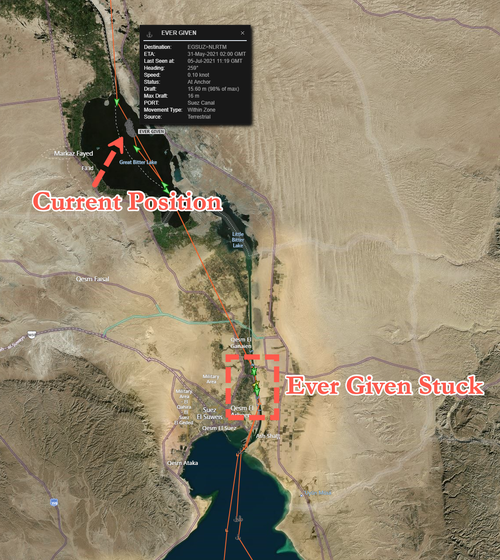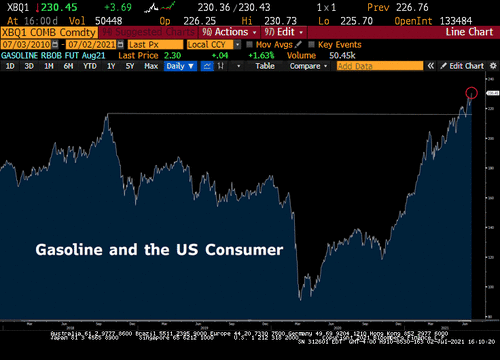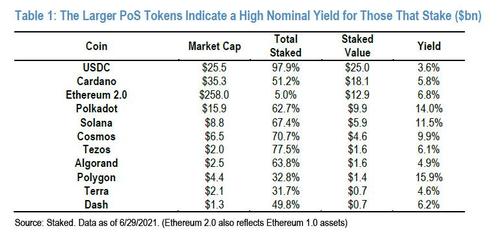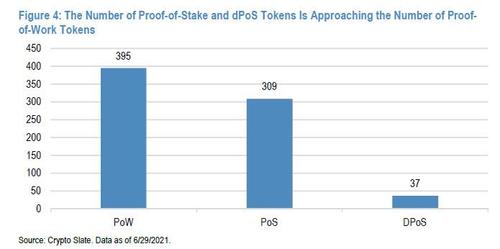Authored by Victor Davis Hanson via AmGreatness.com,
This Fourth of July holiday we might pause for a moment from our festivities to ask how we collectively lost our minds over the last 15 months—and are we yet regaining any semblance of our sanity?
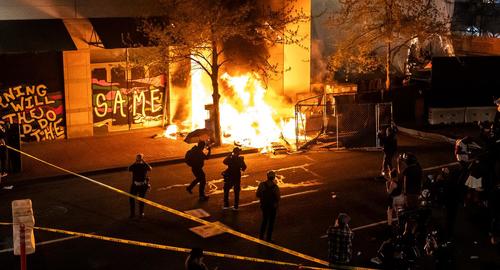
A pandemic caused by the leak of a Chinese-engineered virus and its coverup was cause enough for nationwide madness. But the spread of COVID–19 was followed by a nationalized and often politicized “flatten-the-curve” quarantine that soon ensured a stir-crazy nation. Tens of millions saw no people, and heard nothing human other than what was fed to them through television and computers. No wonder they grew paranoid, conspiratorial, and angry, and soon forgot the therapeutic nature of personal interaction and the shared humanity of being in the physical presence of others.
Our first self-induced recession came next and lasted over a year, destroying all the hard work of the prior three years. Next ensued the death of George Floyd and a subsequent 120 days of rioting, looting, and arson. The immediate costs were $2 billion in damage, over 25 deaths, 14,000 arrests, and a Lord of the Flies anarchy with no-go zones in our major cities. A McCarthyite frenzy followed, as remote-controlled America hunted down the supposed “racists” among us—while career agendas, personal grudges, and ideological hatred fueled the cancel culture.
All this was antecedent to our first election in which Election Day voting was incidental, not essential, to the outcome. This was also our first presidential campaign in which the incumbent was stricken by a pandemic virus. And his opponent, due to his age and infirmity, simply reverted to the 19th century style of staying home and outsourcing the electioneering to the Democratic-media complex. Biden’s basement became the equivalent of the “front-porch” of homebound candidates of a century and more ago.
The derangement was then capped off, first, by a buffoonish riot at the Capitol followed by a Reichstag-fire style militarization of Washington, D.C., in a “never let a crisis go to waste” psychodrama. Then came a novel second and unprecedented presidential impeachment, without a special prosecutor, witnesses, or cross examinations. It was based on the myth of a deadly “armed insurrection” fueled by President Trump, which purportedly led to the murder of a police officer. Later most of the writs of the House impeachment were proven fantasies, from the idea of “armed” and “well-organized” to “murderous” revolutionaries. The only mysteries were the identity of the unnamed officer who fatally shot an unarmed female protester and military veteran, and why the government has still not released thousands of hours of video detailing the riot.
That impeachment charade was followed by a trial in the Senate—without the chief justice presiding—of a president, who was no longer in office.
The finale was the promise of a “moderate” good ol’ Joe Biden from Scranton—the supposed correction to Trump. In reality, Biden’s first 150 days proved, as the cynics predicted, that he was mere cover and conveyance for the implementation of the most radical agenda since the 1930s.
So we can cut America some slack when we ponder why the entire country is now descending into a collective madness, given the amount of propaganda and media distortion pumped out during the quarantine, and since.
The Chaos of Daily Living
Within the space of about 6 months in 2021, the costs of the essentials of life have skyrocketed—food, gasoline, housing, appliances, cars and trucks, and building materials. Non-ending streams of stimulus money, huge deficits, and pent-up demand so far have ensured that Americans would pay such spiking prices. And soon radical inflation may trigger 1970s stagflation and then recession, as the “why-go-to-work?” checks and consumer zeal finally cease, but the government printing machine keeps going. What good is free government money if spiraling prices eat away the entitlement?
California is the worst run of our states. But it is also always a helpful bellwether of where we are descending. The state has plenty of oil and natural gas. There are still remnants of a once thriving nuclear and hydroelectric industry. But power outages are now commonplace—to the point that, like Third-Worlders, we merely shrug when the lights go out as if it were a green way of reducing carbon emissions.
Forty million people driving on roads and highways intended for 20 million people—27 percent of them not born in America—becomes a “Road-Warrior”-like wildness intended to discourage the kind of driving to which we became accustomed in the 20th century. Any trip over 200 miles cannot be calibrated by traditional “arrival times.” Ad hoc repairs on ancient roads paralyzes traffic not already slowed by accidents. Speeding and traffic violations are commonplace. Either the population ignores or does not know the law, or a paranoid law enforcement is reluctant to enforce the laws, or there are simply too few patrol cars responsible for too many drivers.
Gas can range from $4.00 to over $5.00 a gallon; $100 fill-ups are common. To go to a California Home Depot or Lowes store is to be amazed at grades of plywood priced at nearly $90 a sheet.
Californians are leaving in droves, but housing costs are still soaring. Californians love nice houses. But those who have them don’t like to allow anyone to build new ones for others.
A horrendous drought has dried up reservoirs and dropped the water tables of most aquifers. Privately, Californians know that it was madness not to build reservoirs, all cancelled over 30 years ago, or to allow the California Water Project’s infrastructure to decay, or to continue to allow scarce fresh water to flow into the sea, or not to invest in new technologies of underground water savings and storage.
But they also know that as long as the Bay Area’s activists have sufficient supplies of water (from their own early 20th century, far-seeing politicians who created the huge Hetch Hetchy transference and won first-dibs allotments from the subsequent California Water Project), they will continue to push green agendas, the disastrous consequences of which the elite avoid, given their own wealth and power.
High-speed rail is a tragic joke. It is inert and unfinished. The ostentatious half-built overpasses stand like modern graffiti-stained versions of Stonehenge. Its only ostensible purpose seems to have been a green plan to siphon money from road repair and expansion.
Mention San Francisco to a Californian, and the same, monotonous warnings arise: don’t go there! And if you must, don’t park there—since smashing into a car and stealing its contents are viewed as understandable redistribution rather than criminal acts. Others advise to check constantly the soles of your shoes: human and animal excrement is ubiquitous as the city’s sanitation regresses to something resembling Old Cairo or medieval London.
I drive often to the central Sierra. For the last 4 years the talk there was “Why don’t they do something about the millions of trees that have died from drought and bug infestation?” The locals now say of the incinerated forests “Why don’t they do something about the millions of those charred black trees?” Such sincere questions assume people matter more than ideology. They don’t.
In a state where defecation on the sidewalks apparently hurts no one, drought and fires consuming a forest are also OK—as long as it is likewise deemed a function of nature. In California, logging an acre of timber is insurrectionary; 400,000 acres going up in smoke is “stuff happens.”
Policies and Politicians
The truth is that the necessities of life—safety, affordability of the essentials, transportation, power, and fuel—are now iffy. If 15 years ago, Americans more or less saw each other as fellow citizens rather than as members of rival tribes, now they are resegregating into Dark Age bands. In place of oral bards and mythic sagas, we have dry and racist “critical race theory.”
There is no media credibility left after assuring us for years that the Steele dossier was the gold standard, that Robert Mueller’s dream team would prove “collusion,” that Donald Trump sicced the federal police on demonstrators for a cheap photo-op stunt, that Hunter Biden’s laptop was Russian disinformation, and that only conspiracists could make a looney connection between COVID-19’s ground zero origins in Wuhan and a nearby level 4 virology lab, with ties to the Chinese military.
The current chaos of everyday life of course follows from national policy and politics. The streets are on a reverse trajectory into the 1970s, since crime is redefined as either tolerable collateral damage, “equity,” or a collective indictment of society rather than one of individual culpability. When mayors claim that burning a police precinct is a mere loss of “brick and mortar,” or taking over downtown Seattle is just part of a “summer of love,” or when the architect of the “1619 Project” claims looting is not violence, then crime is no longer crime.
The Left says it has not defunded the police because there are still police to be seen. But progressives have done something far more insidious: America has destroyed police deterrence by a year of anti-police venom, by prosecutors selectively and asymmetrically exempting the arrested, and by prompting police retirements, resignations or simple slowdowns. There is now in the minds of all big-city cops a constant cost-to-benefit calculation: going into the inner city has become a lose/lose/lose/lose/lose proposition in which a 911 call from the danger zone can get an officer killed, injured, fired, suspended, imprisoned, or rendered a fool, as the successfully arrested are summarily let go.
The country has gone mad with debt. Both parties are responsible for the massive spending. The Republican defense is that Democrats would spend even more—and, if they are lavishing entitlements to buy votes, why shouldn’t we?
The Left’s excuse is not just the old idea of redistribution, but a new revolutionary myth that money and debt are really irrelevant constructs. A novel economic pseudoscience has revised or discarded the oppressive idea of having to pay back what was borrowed.
Traditionalists and conservatives always assumed that the military, the intelligence and investigatory agencies, and the prosecutorial industry were at least above politics, defenders of traditional and constitutional norms, and completely professional in their service.
No longer. There is now a new military-industrial-intelligence-legal complex. Its hierarchy is politically weaponized, and amply renumerated. The careers of John Brennan, James Clapper, James Comey, Andrew McCabe, General Mark Milley and a score of retired 4-stars officers, Robert Mueller and his dream team, and the Department of Justice are characteristically determined and calibrated by politics rather than competence.
The usual consequences follow: half the country no longer trusts its once esteemed FBI, CIA, or military. And when these agencies veer from their assigned tasks, it is no wonder that they miss impending signs of terrorism in Boston, Fort Hood, and San Bernardino, had little clue that the “JVs” of ISIS were expanding in Iraq, and never really informed the American people about the costs, the benefits, the stakes and the likely future of the two-decade Afghan war. In the 1960s the Left sought to tarnish the reputation of what they saw as hated government institutions and failed; in the 2020s, the Left diminished the reputation of what they now saw as useful and malleable institutions and succeeded.
America does not quite know what will follow from the first months of the Biden Administration. Already, it has managed to destroy the idea of a border, with an anticipated 2 million entering the country illegally over a 12 month period. It demolished the idea of the police and prosecutorial deterrence curbing crime. It is ending the trajectory of America’s natural gas and oil renaissance that enriched the country, and freed it from Middle East entanglements. And it killed off the notion that government should seek to ensure that race is not how we collectively define the content of our individual characters.
Abroad
Meanwhile, our enemies and rivals—China, Iran, and Russia especially—are giddy at what America has become. The American Left, they believe, has done a much better job of denying Chinese culpability for a Chinese-engineered virus than had the Chinese communist media.
When billionaires, such as Michael Bloomberg, see China as essentially democratic (“The communist party wants to stay in power in China, and they listen to the public . . . Xi Jinping is not a dictator.”), when Charles Munger applauds their clampdown on outspoken capitalists like Jack Ma (“I don’t want the, all of the Chinese system, but I certainly would like to have the financial part of it in my own country, . . . Communists did the right thing. They just called in Jack Ma and say, ‘You aren’t gonna do it, sonny.’””), and when Bill Gates believes that in the midst of the pandemic, a lying China had done “a lot of things right in the beginning,” we can conclude America’s richest are placing their bets on a Chinese-Communist controlled 21st century, and will adjust accordingly.
Our adversaries can’t quite believe their good fortune. Had they thought up ways to divide and impoverish America, to see its cities burned, and looted, to weaken its economy and currency, to erode the unity of its once feared military, and to entrench the most effective critics of America in America—not in Beijing, Moscow, Pyongyang, or Tehran, but in corporate boardrooms, campuses, newsrooms, Hollywood, Wall Street and the Pentagon—they could not have improved on what has happened in 2020-21, the era of our collective meltdown.



